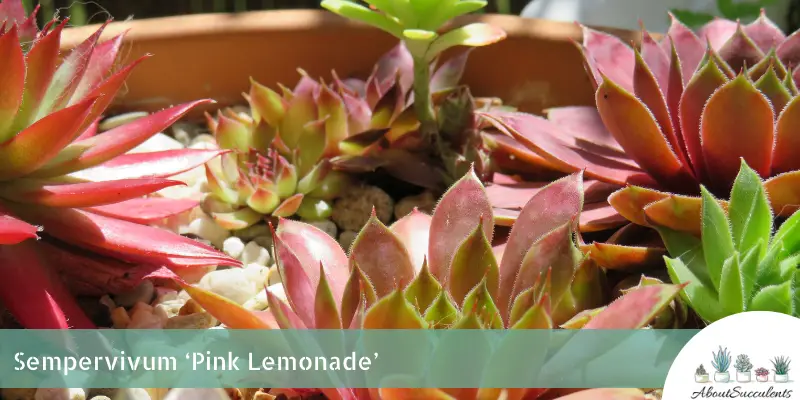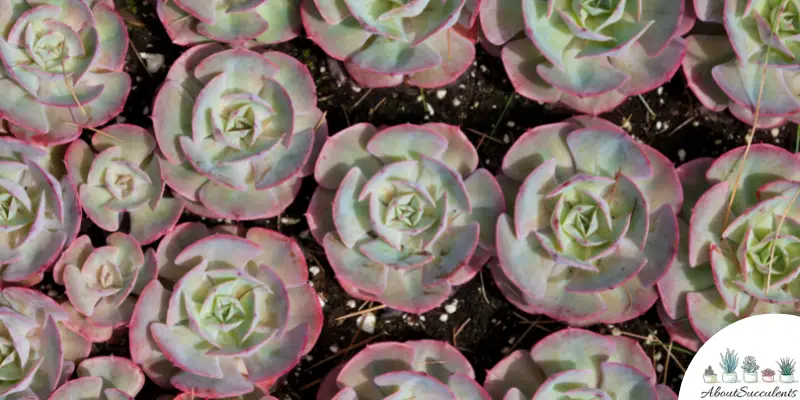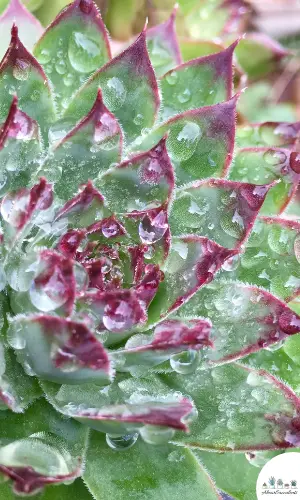
Sempervivum “Pink Lemonade” is a beguiling succulent because the colors of its leaves change depending on the season and temperature. It starts out with light-colored pink or green leaves in the spring but as the season heads to summer and the temperature rises, the colors become brighter.
As the season approaches fall and winter, the leaves take on darker hues of grey-blue and purple. The chameleon-like leaves grow into stunning rosettes that are approximately 3-inches (7.62cm) tall and 8-inches (20.32cm) wide.
Another name for Sempervivum Pink Lemonade is “Hens and Chicks” because it grows offsets or pups that can be used to propagate the species. Some nurseries might display it under another alias, “Houseleeks”.
Hens and Chicks is a monocarpic succulent which means the plant dies after it produces flowers. However, typical of monocarpic succulents, it takes years before it can bloom.
If cared for properly, Pink Lemonade will produce small, star-shaped, pink-colored flowers in the late summer or early fall seasons.
Sempervivum Pink Lemonade is a hybrid created by Polly Bishop from S. Magnificum, originated from the United States, and is a member of the Crassulaceae family.
General Information
Also known as: Pink Lemonade, Hens and Chicks, Houseleeks
Plant Family: Crassulaceae
Origin: United States
Height: Grows up to 3-inches (7.62cm)
Exposure: Partial to full sunlight for up to 6 hours per day.
Water Needs: Survives long periods without water; follow the “Soak and Dry” method.
Soil Type: Commercial succulent soil or potting soil combined with 50% pumice, perlite, and coarse sand.
Soil pH: 6.6 – 7.5
How to Grow and Care for Sempervivum “Pink Lemonade”

Does your region experience frosty weather whereby mercury falls below -30°F (-34.4° C)? If so, Sempervivum Pink Lemonade is the ideal succulent for your outdoor garden.
Most succulents can tolerate drought but not frost. Pink Lemonade thrives even if it’s under a blanket of snow. You have nothing to worry about if your region has winter because Sempervivum will do just fine.
Its resilience against extreme changes in temperature makes Hens and Chicks one of the easiest types of succulents to grow and care for.
Sunlight
Sempervivum Pink Lemonade needs a good amount of sunlight to achieve its bright colors.
If you decide to display Houseleeks in a rock garden or as ground cover, it must be planted in an area that gets 6 hours of partial or full sunlight. What you need to remember is to protect Sempervivum from the afternoon sun because its rays can burn the magnificent leaves.
As a houseplant, look for a location where the succulent can get 4 to 6 hours of partial sun. You might want to put Pink Lemonade under a Grow Light for 6 hours per day to ensure it gets its daily dose of sunlight.
Failure to provide enough sunlight for Pink Lemonade will cause its leaves to stretch out and wither. This condition is called etiolation and could spell the end for Sempervivum.
Watering

If Sempervivum Pink Lemonade needs sunlight every day, the exact opposite is true when it comes to giving your succulent water.
Succulents store a lot of water in their leaves and stems allow them to survive drought conditions. Watering the soil frequently will do more harm than good.
Soil that stays wet for a long time becomes a potential breeding ground for fungi and other forms of bacteria. Likewise, the roots of Pink Lemonade will rot if kept in a prolonged moist environment.
The roots will rupture and provide an opening for the fungi to infect Sempervivum Pink Lemonade.
When it comes to watering Pink Lemonade, less is best. Follow the “Soak and Dry” method.
First, check the soil’s level of dryness. Simply insert your finger or a stick an inch deep into the soil. Pull out the stick and if the end feels dry, prepare to give the soil a good soaking.
If Houseleeks is planted in a pot, stop watering when you see water coming out of the drainage hole.
Second, only water the soil. Don’t water the plant itself because this will cause moisture to be retained longer.
In the spring to summer months, expect to water Sempervivum every seven to 10 days. During the colder months, the soil will stay moist longer. You’ll probably need to water the soil only once a month.
Pot and Soil
The best choices for pot and soil are varieties that support soil aeration and speed up drainage. When growing and caring for succulent plants, you don’t want to retain moisture for a long time.
Many nurseries and gardening stores will keep succulents in plastic containers. Remove Hens and Chicks from the plastic container and repot in terracotta or unglazed ceramic pot.
Terracotta and unglazed ceramic are the preferred types of pots because they allow moisture to escape from the soil quickly. These materials also support proper soil aeration.
Buy a pot that’s slightly larger than the base of the plant to keep the roots from getting entangled. Check that there’s a drain hole at the bottom to let excess water trickle out.
You can use commercially available succulent soil for Hens and Chicks or make your own by combining potting soil with 50% coarse sand, perlite, and pumice to improve drainage.
How to Propagate Sempervivum “Pink Lemonade”
If you can get enough of Sempervivum Pink Lemonade, you can add more of the species to your outdoor garden by propagating from offsets.
Step 1: Get a sharpened knife and sterilize it with 70% isopropyl alcohol. Use the knife to loosen up the offsets growing near the base of Hens and Chicks.
Step 2: Pull out the offsets from the soil.
Step 3: Let the offsets rest in a dry area. Give it 2 to 4 days to develop hard calluses.
Step 4: Plant the callused offsets in well-draining soil. Lightly moisten the soil with water. Moisten the soil regularly while the roots haven’t formed yet.
Step 5: Place the pot near a window that gets up to 6 hours of partial sun.
Step 6: Once the roots have formed, back off the watering schedule and follow the “Soak and Dry” method.
Frequently Asked Questions
Is Sempervivum “Pink Lemonade” Toxic to Cats and Dogs?
Sempervivum Pink Lemonade is not included in the list of plants as toxic to cats and dogs on the website of the American Society for the Prevention of Cruelty to Animals (ASPCA).
Why is My Sempervivum “Pink Lemonade” Dying?
If your Sempervivum Pink Lemonade doesn’t look like it’s in the pink of health, the problem could be related to overwatering or pest infestation.
Hens and Chicks will get healthy again if you follow our remedies below and act quickly.
Overwatering
Overwatering is the leading cause of succulent death. Once the fungi have entered the succulent through roots that have rotted away, an infection can spread immediately.
Discoloration and a mushy feel to the leaves are symptoms of infection through root rot. Don’t waste another second and cut off the infected sections of the plant with a sterilized knife or garden shears. Disinfect the cutting tool with 70% isopropyl alcohol after every use.
Remove Houseleeks from its pot and cut off all of the infected roots. Allow the plant to recover and dry out for 1 to 2 days. In the meantime, prepare a new pot with fresh well-draining soil.
Plant Pink Lemonade in its new home and give it 2-3 days to get used to the environment before watering the soil.
Pest Infestation
You don’t see them but if you notice white, waxy, cotton-like substances on the leaves, 100% sure the pests are hiding in Pink Lemonade’s leaves. These substances are byproducts of the mealybugs that feed on the succulent’s sap.
Get a cotton ball and soak it in 70% isopropyl alcohol then wipe off the substances on the leaves. Unattended to, these substances can infect Hens and Chicks.
Spray Sempervivum Pink Lemonade with a natural insecticide such as diluted neem oil to keep the pests away.
It might take years, but Pink Lemonade will produce small, star-shaped, pink-colored flowers in the late summer or early fall seasons.
Last Updated on June 9, 2022 by Sofia Lara